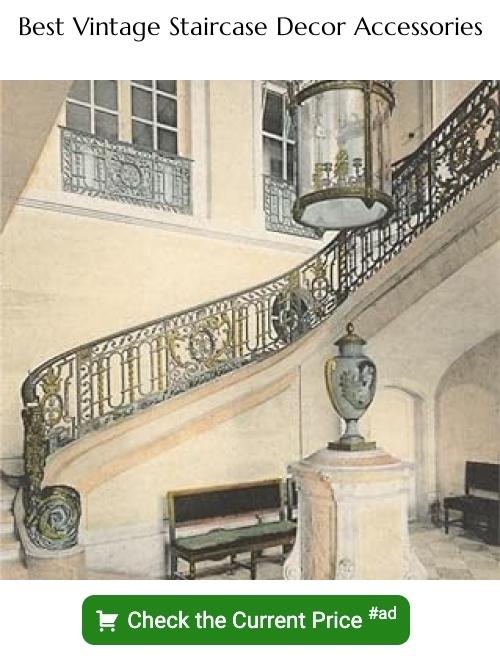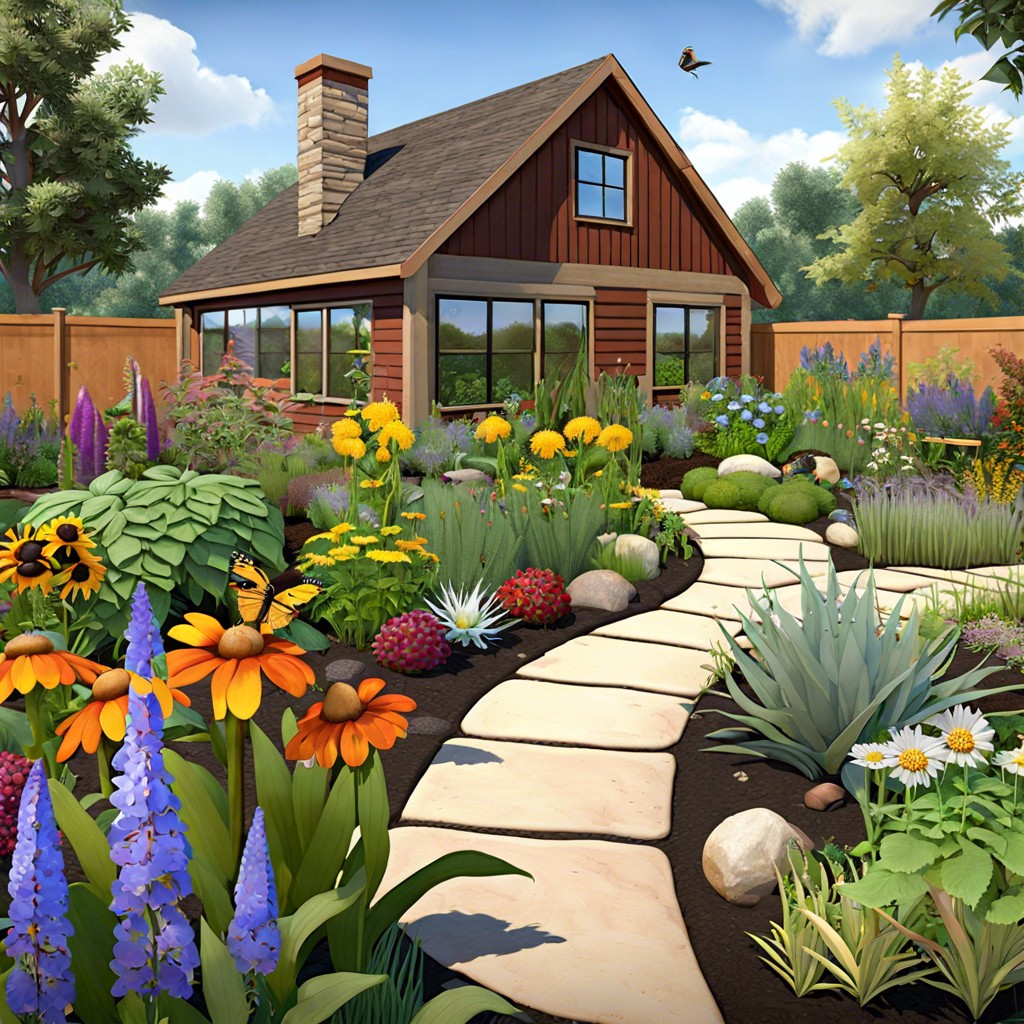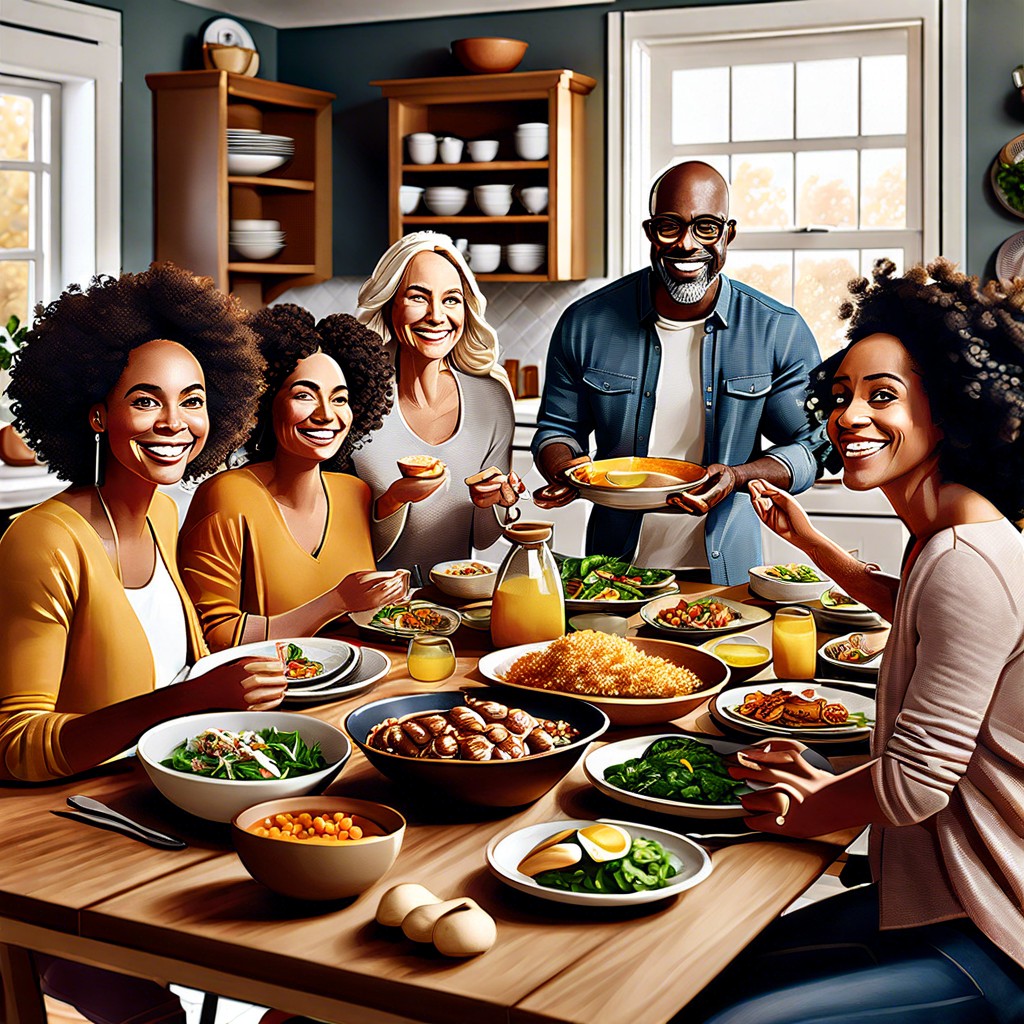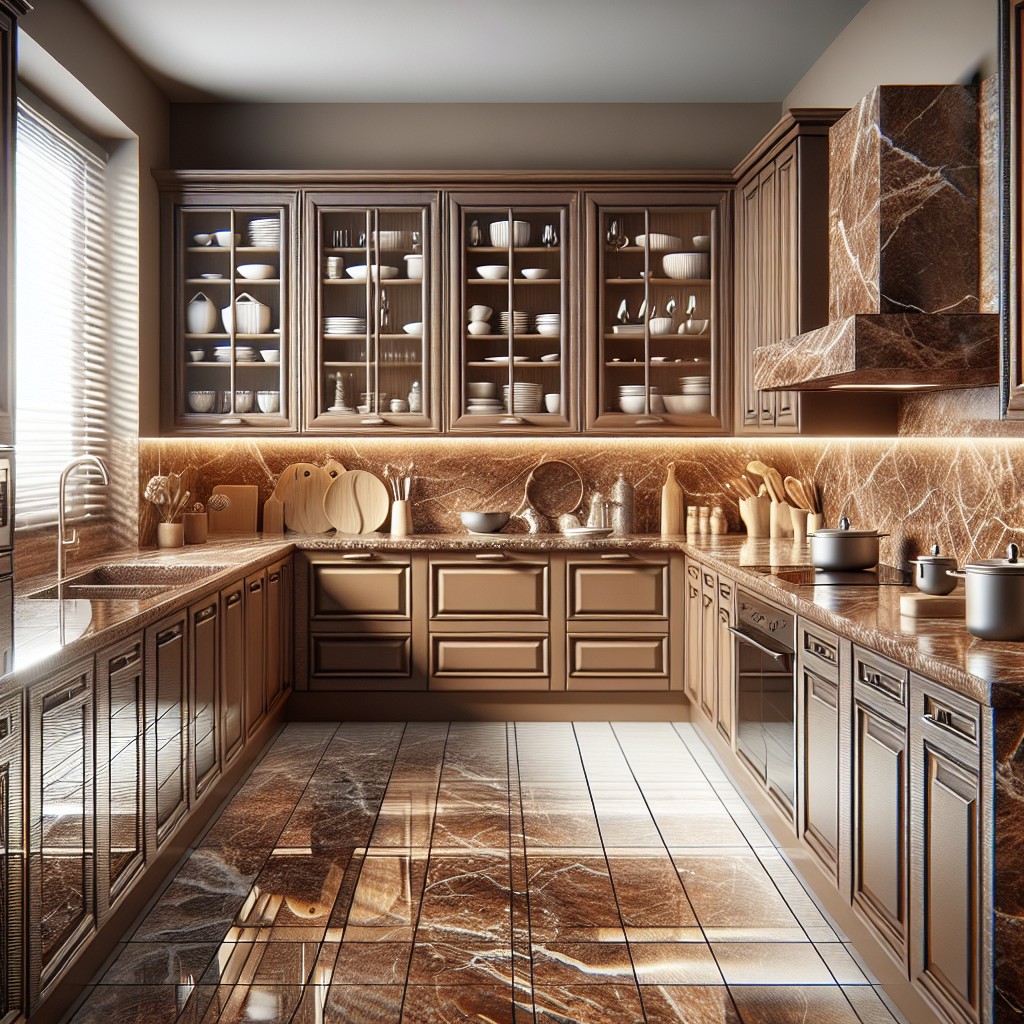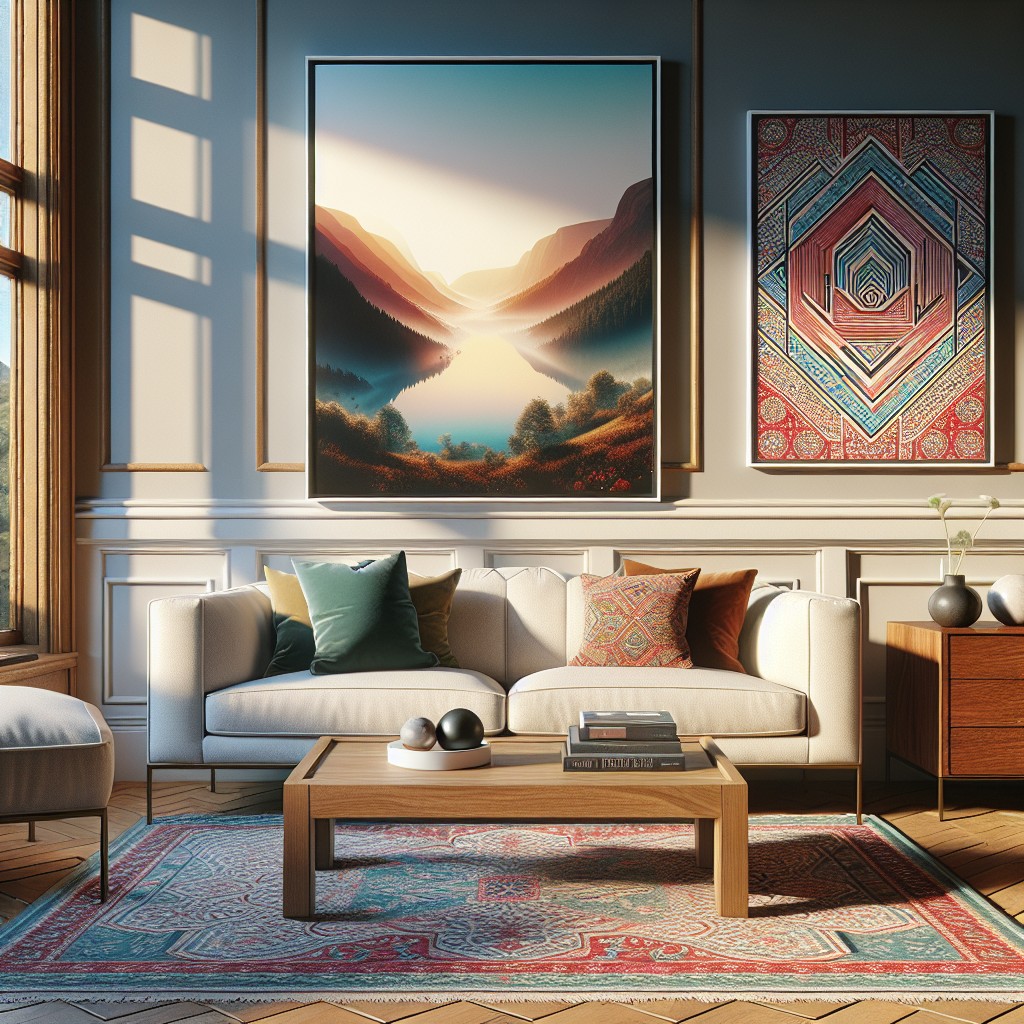Last updated on
Explore these antique staircase ideas because they will effortlessly infuse your home with a sense of history, character, and charm.
These are my unique design concepts made using design tools. I hope you find them inspiring!
Step into the world of fascinating antique staircase designs. While there is an abundance of ideas on the web, the aim here is to tread those lesser-known paths, presenting you with a selection of unique and refreshing concepts.
From subtle transformations to intricate revamps, a fresh perspective on antique staircase design awaits. As a helpful bonus, a curated list of resources, featuring best of the existing ideas, is packed in at the end.
Now, let’s embark on this design journey to discover eye-catching ideas that blend timeless charm with innovative twists.
What's Inside
Antique Staircase in a Minimalist Home
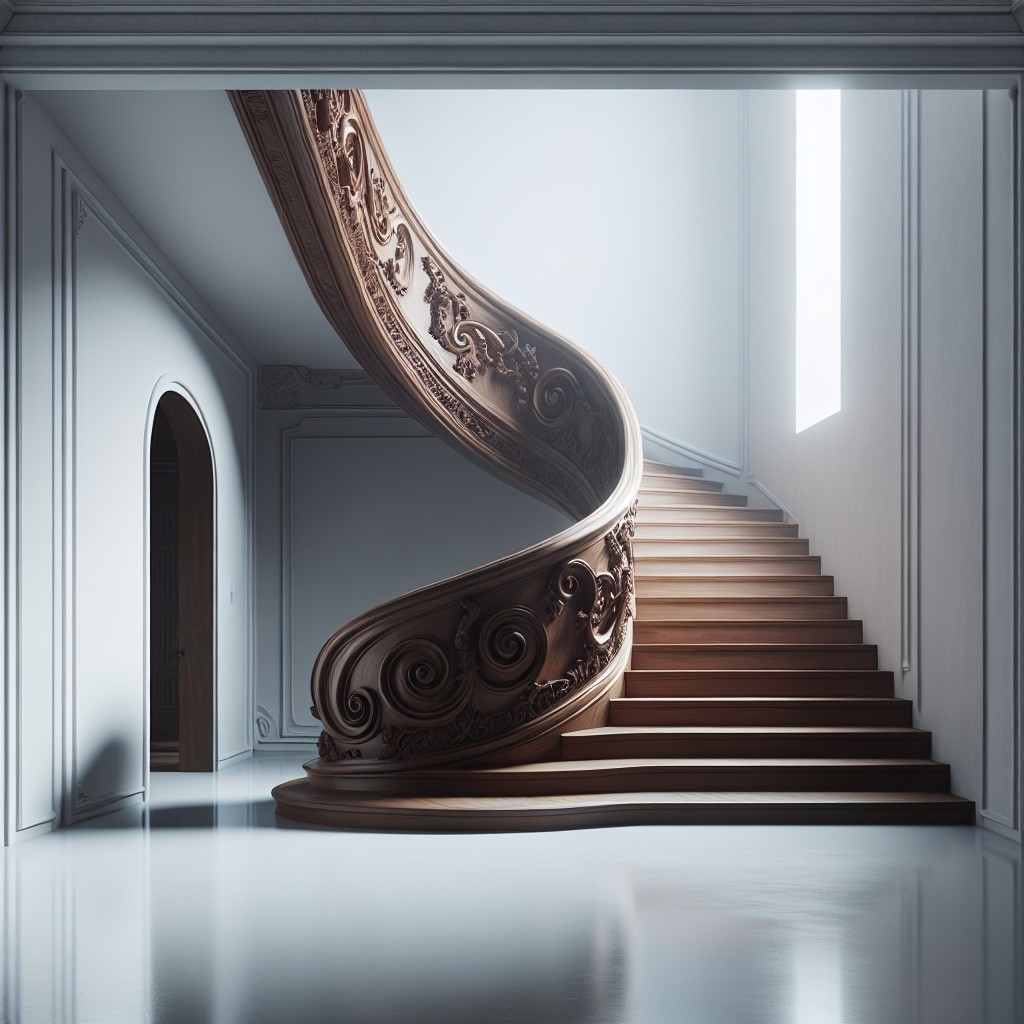
Choosing a minimalist approach for your antique staircase doesn’t compromise its historical charm, instead it highlights it. Implement clean lines for railings and balusters. Opt for tones like matte black and white; they not only add timeless elegance but also accentuate the age and character of the stairs.
Maintain minimal ornamentation and rely heavily on the striking architecture and raw materials of the staircase to remain the focal point. To complement the minimalism, consider a light, neutral paint job for walls adjoining your staircase, which provides a modern backdrop that can really allow the details to stand out.
Keep décor items, such as frames or vases, sparingly and of monochrome tones.
Victorian Trims for a Classic Look
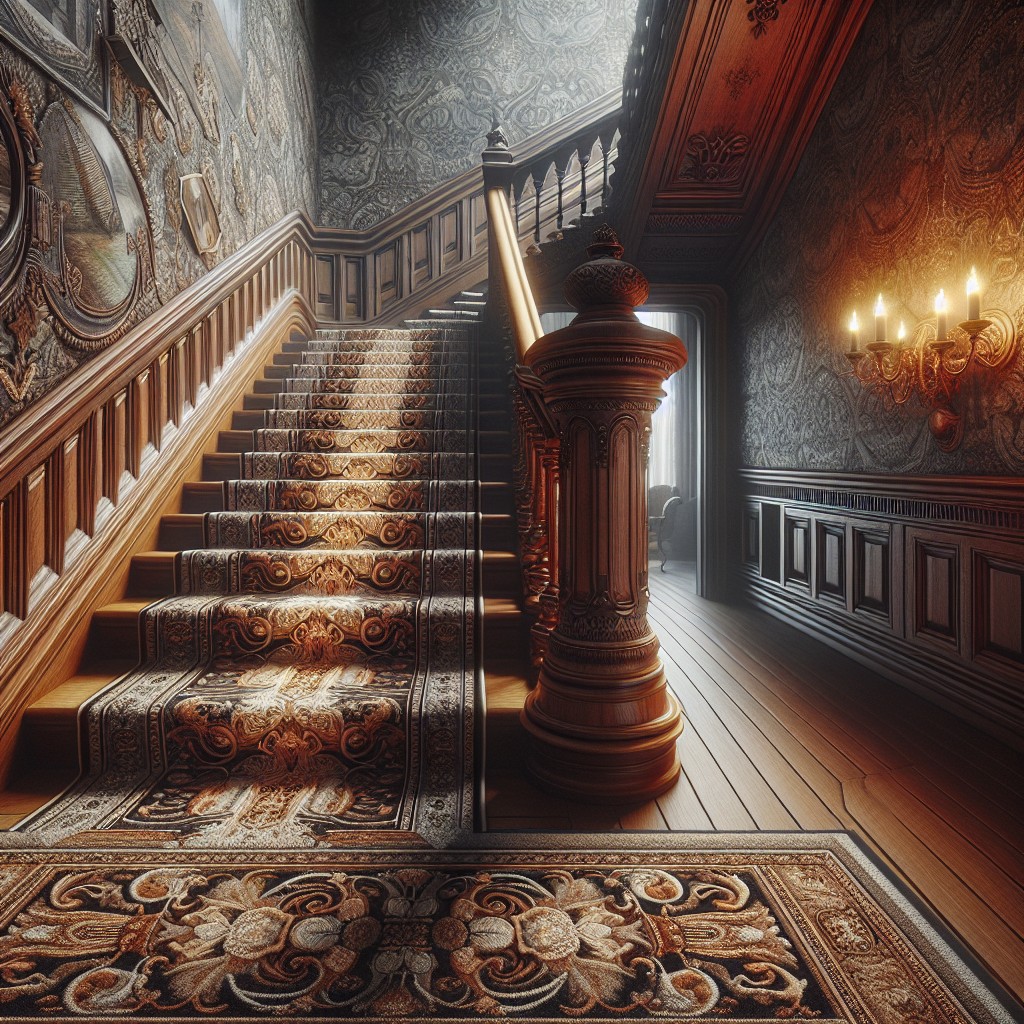
Exuding elegance and sophistication, Victorian trims are a fantastic way to infuse a dose of classical grandeur to your space. These trims, also known as mouldings, are often intricate and rich in detail, reflecting the more lavish era of the Victorian period.
When incorporating these ornate features into your staircase, here are some key points to bear in mind:
- Material Choice: Opt for hardwood for authenticity. Hardwoods commonly used during Victorian times include oak, mahogany and walnut, renowned for their robust nature and attractive grains.
- Design Details: Victorian trims often boast intricate carvings, such as florals or scrollwork. Aim to replicate these in your own design for a truly Victorian ambiance.
- Combination: Pair your trims with coordinating panels. Wainscoting or raised panels painted in rich, deep colors can add to the overall traditional aesthetic.
- Preservation: Victorian-era homes are notable for their commitment to craftsmanship. Retaining and restoring any original mouldings can help to bolster the classic Victorian charm of your staircase.
- Expert Consultation: Due to the intricate detailing, it might be worthwhile seeking a professional’s hand in installation. Their expertise in working with such ornate designs can make the process smoother and yield better results.
Remember, the essence of Victorian design is all about richness, boldness, and contrasting tones and elements. Use it intelligently to create a hallway that evokes a sense of opulence and grandeur reminiscent of another era.
Restoration Tactics for Antique Staircases
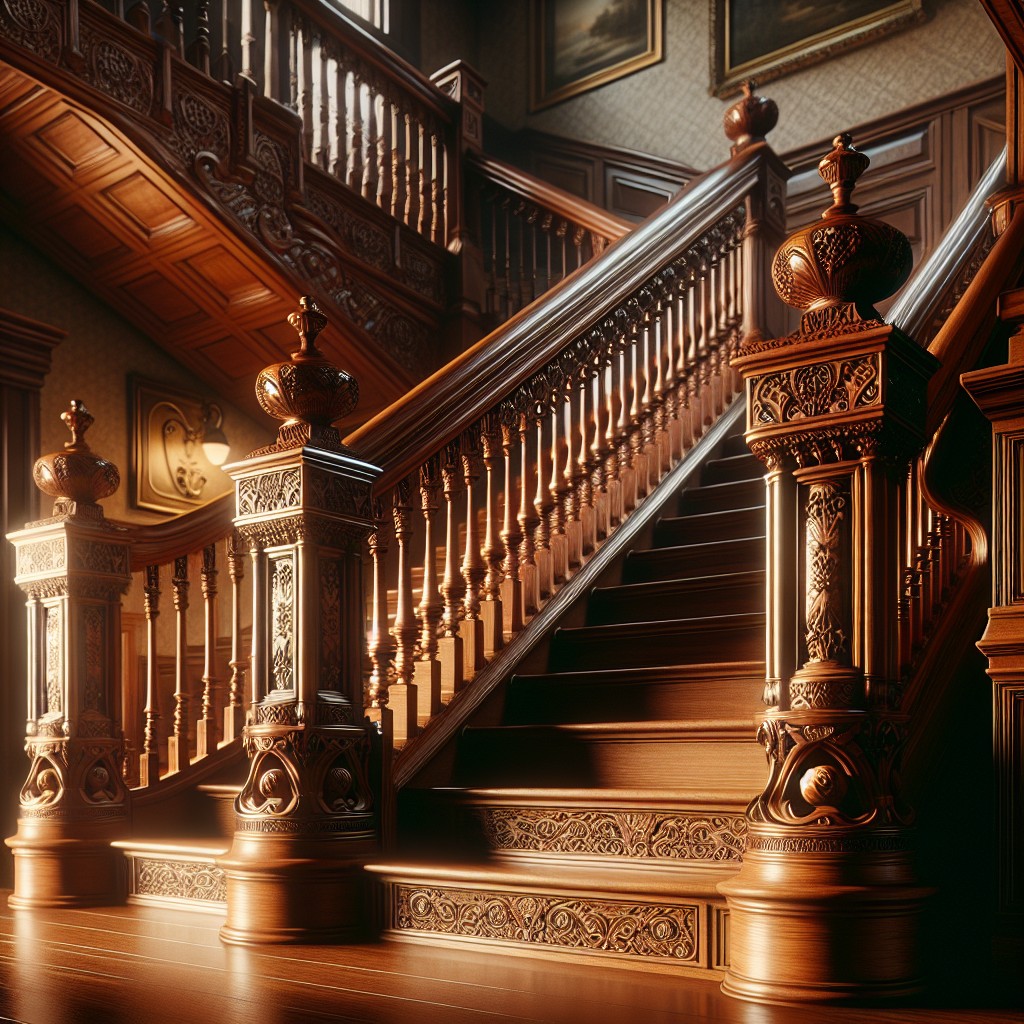
Restoration is an integral part of reviving the glory of antique staircases. It necessitates delicate care along with the knowledge of various techniques and materials.
1. Assessement: The first step is to accurately measure the extent of repair needed. This might involve looking for loose parts, damaged woodwork, or corroded metals.
2. Material Replacements: It’s important to source materials that match the original staircase to maintain consistency. For instance, Victorian designs often included mahogany or oak while aged pine was often found in late Georgian designs.
3. Cleaning: A soapy mixture applied gently can clear lots of dirt and grime. Avoid power washers or any abrasive cleaning tools that could damage the staircase’s structure.
4. Repair and Replacement: Loose rails, cracked balusters, or split steps should be fixed. Restoration specialists can often replicate intricate designs for pieces that need replacement.
5. Finish: Finally, applying a finish protects the material and enhances the stair’s existing character. It’s recommended to do a patch test to ensure the color matches the rest of the staircase.
Always seek professional assistance when unsure. Restoration needs careful handling and a botched job can not only ruin the aesthetic but can also be a safety concern.
Keeping the Patina: Unpolished Antiques
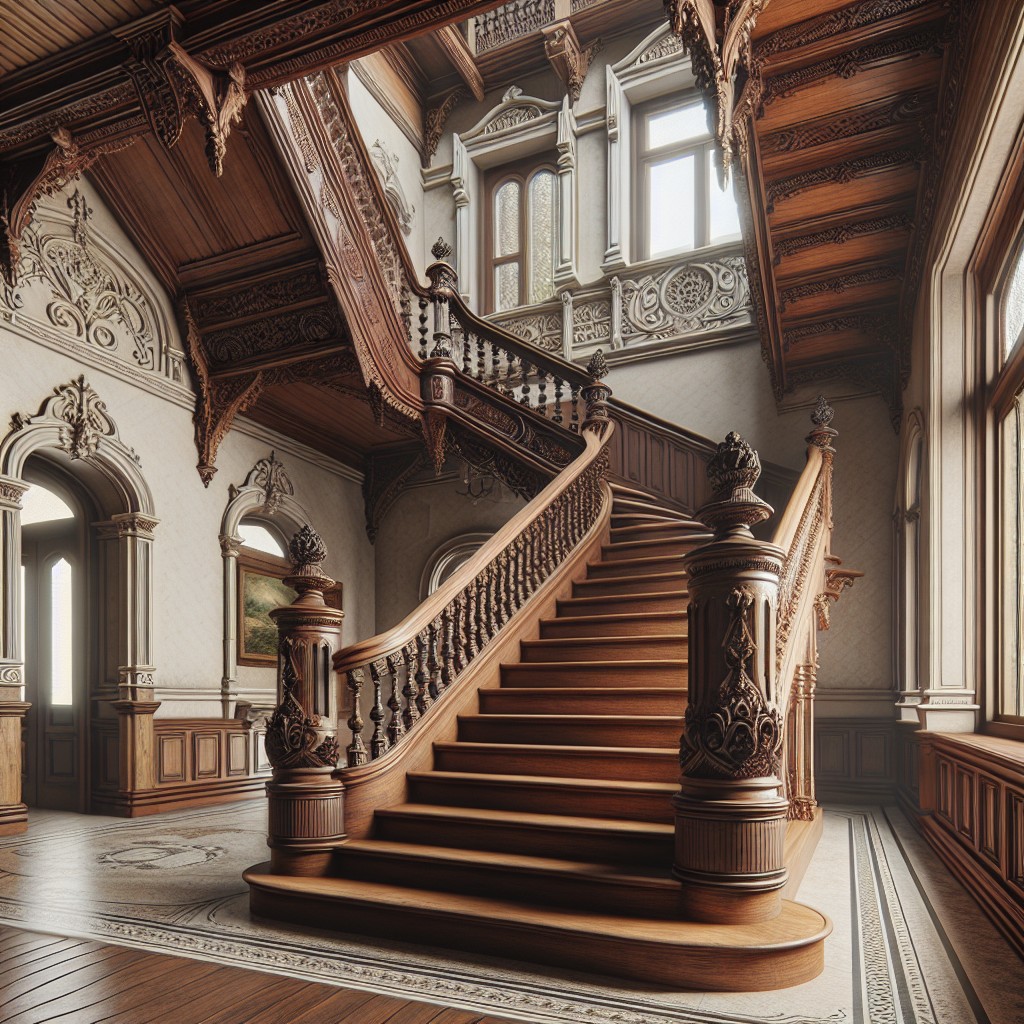
Preserving the original finish of an antique staircase often means containing the irresistible urge to polish it. Although this may seem counterintuitive, it’s often the acquired patina that gives antiques their charm, a testament to their journey through time.
Consider these factors when maintaining the patina of an unpolished antique staircase:
- Identify Vintage Materials: Common materials like oak, walnut, mahogany and pine age differently. Understanding the composition allows you to care for the staircase properly.
- Maintain Regularly: Regular light cleaning wards off dust accumulation and helps prevent any damaging build-up. Use mild soap, a soft cloth, and avoid abrasive cleaners.
- Handle with Care: Avoid heavy or sharp objects that could damage the surface. Damage to the patina can alter the appearance of the entire piece, sometimes irreversibly.
- Stay Humid: Purchasing a humidifier can help combat dry environments that speed up ageing, leading to cracks or warping in the wood.
- Final check: As a rule of thumb, always consult professionals before making any drastic changes. They’ll be able to guide you with advice specific to your antique staircase.
Spiral Staircases and Their Vintage Charm
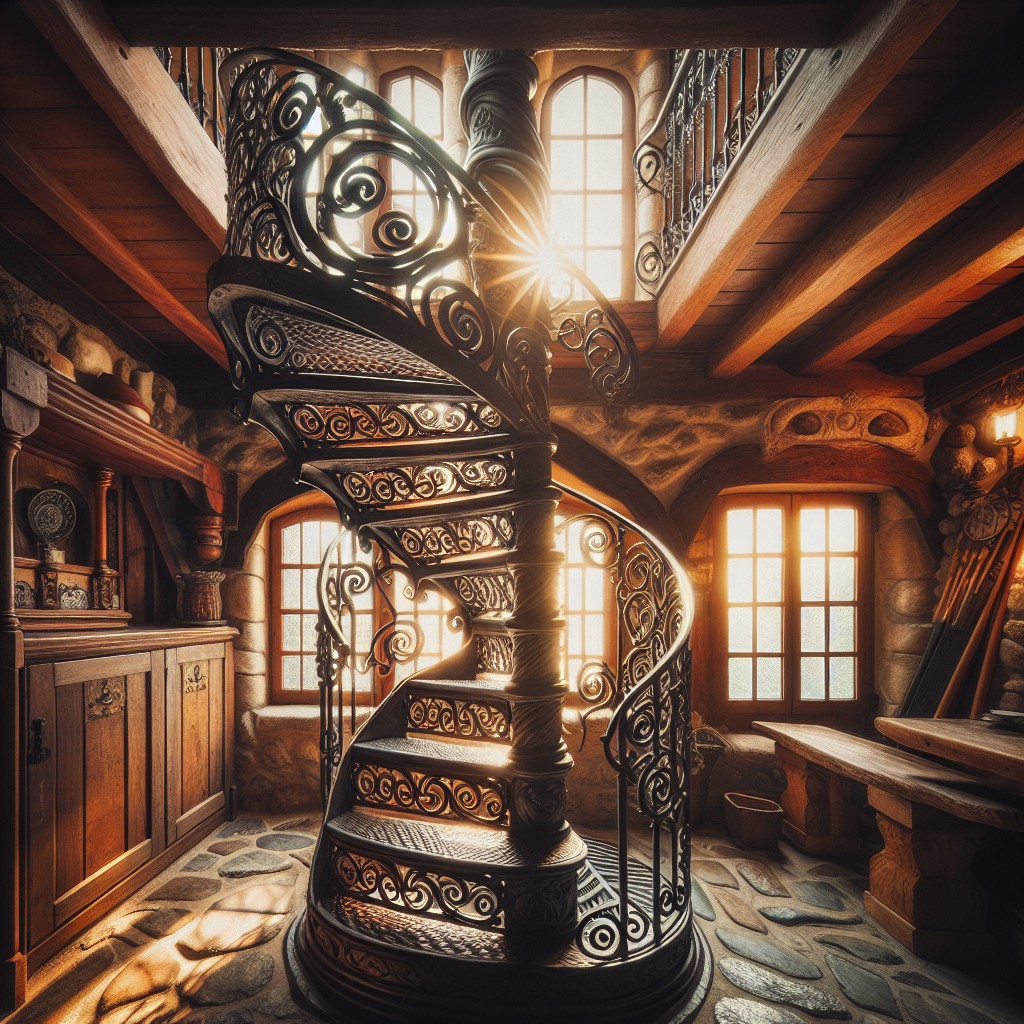
The twisting, curving pattern of spiral staircases provides an undeniably romantic appeal. Originating from medieval times, these staircases add a dash of history and intrigue, making any space instantly captivating.
There are certain elements that play into the charm of vintage spiral staircases:
- Material: Typically constructed from wrought iron or wood, these materials add authenticity and age to the design. Wrought iron boasts strength and dramatic appeal, while wood offers warmth and rustic charm.
- Design Intricacies: Ornate details on the spiral railings or steps add to the vintage charm. These designs run the gamut from floral motifs to intricate geometric patterns.
- Space-Saver: A practical advantage of spiral staircases is that they save a lot of floor space, making them ideal for compact homes.
- Natural Light: The open design of spiral staircases allows for natural light to pass through, creating an airy and pleasant atmosphere.
- Focal Point: The eye-catching, asymmetric design of a spiral staircase makes it a natural focal point in any room.
Consider these aspects when integrating a spiral staircase into your home layout for an infusion of vintage charm and practicality.
Wood and Iron: A Timeless Combination

Marrying the rustic appeal of wood with the industrial strength of iron creates a timeless aesthetic that pays homage to traditional craftsmanship. This combination goes well with most interiors, offering versatility and elegance.
1. Wood Types: Each variety offers its distinct color and grain. Walnut, for instance, showcases rich, dark hues, whereas oak features a lighter, more neutral tone. Reclaimed wood is an admirable choice for its historic value and unique, aged look.
2. Iron Details: Elements like iron balusters bring in a visual twist. Opting for intricate designs or sticking to simpler shapes will depend on your preferred stylistic balance between elaborate and minimalist.
3. Balancing Act: Keep in mind that both materials should complement and not compete with each other. For a harmonious design, if the wood is heavily grained or contains knotty patterns, consider plain iron railings. Conversely, ornamental ironwork pairs well with smoother wood surfaces.
4. Personalization: Introducing personal touches like an iron handrail with a custom design or a wooden step made from family-owned lumber can enhance your staircase’s individuality.
Remember, antique should never mean a compromise on safety features. Always ensure your staircase is built to meet modern safety standards while still preserving its historical charm.
Marbled Staircases From Antiquity
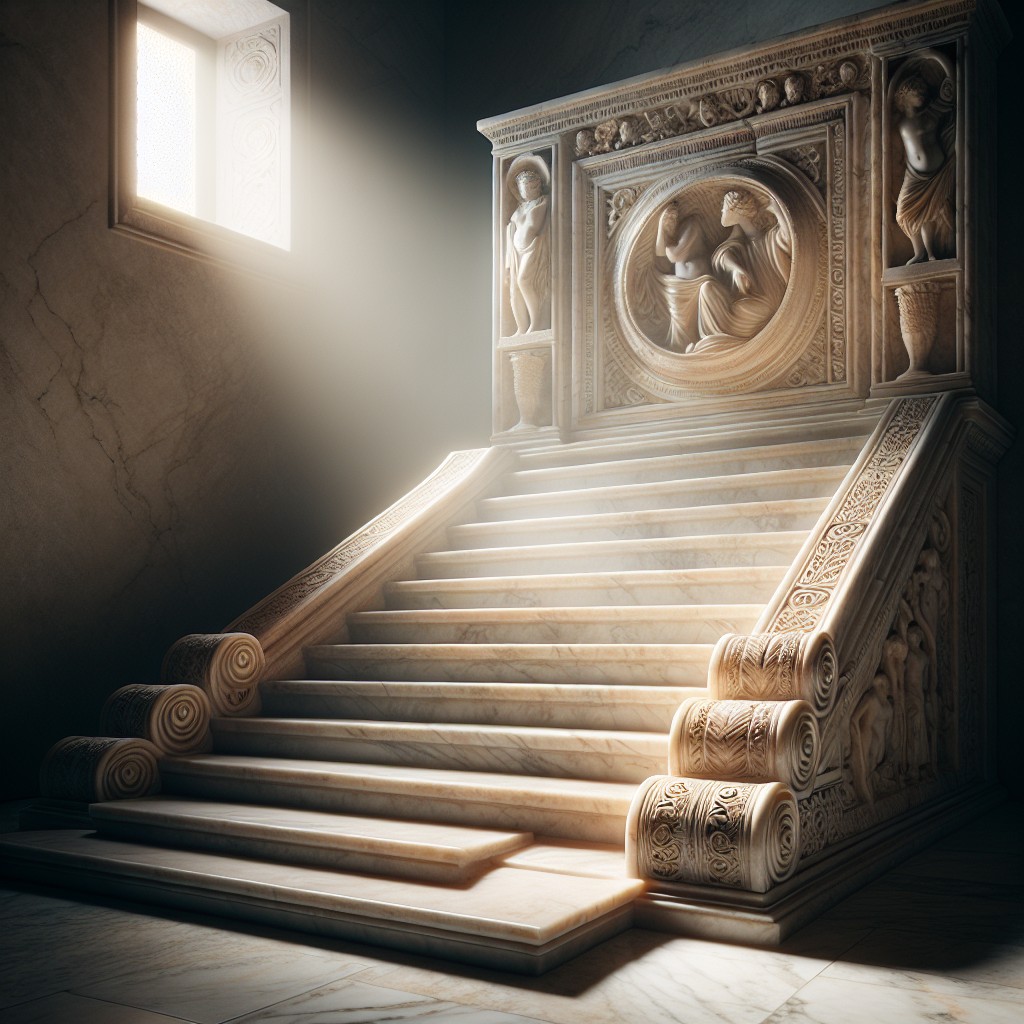
Marble has been a symbol of wealth and status since ancient times, rendering it a fitting material for a statement staircase. The cool, smooth surface of marble offers a natural elegance, ideal for an architectural centrepiece. Not only is it aesthetically appealing, its durability also withstands the test of time, often outlasting the building around it.
Use the underlying colors in the marble to inspire the rest of your decor scheme. Warm-toned marbles can benefit from similar neutral colors, while cooler marbles pair beautifully with grays or blues. To maximize the effect of a grand marble staircase, keep the surrounding decor understated. The hue and natural patterns in marble can guide the selection of accompanying materials and textures.
For maintenance, regular cleaning with a non-acidic product will prevent staining and enhance the stone’s natural luminance for a glamorous shine. Invest in professional sealing every few years to ensure long-term preservation of this timeless antique element.
Decorating With Runner Carpets On Antique Staircases
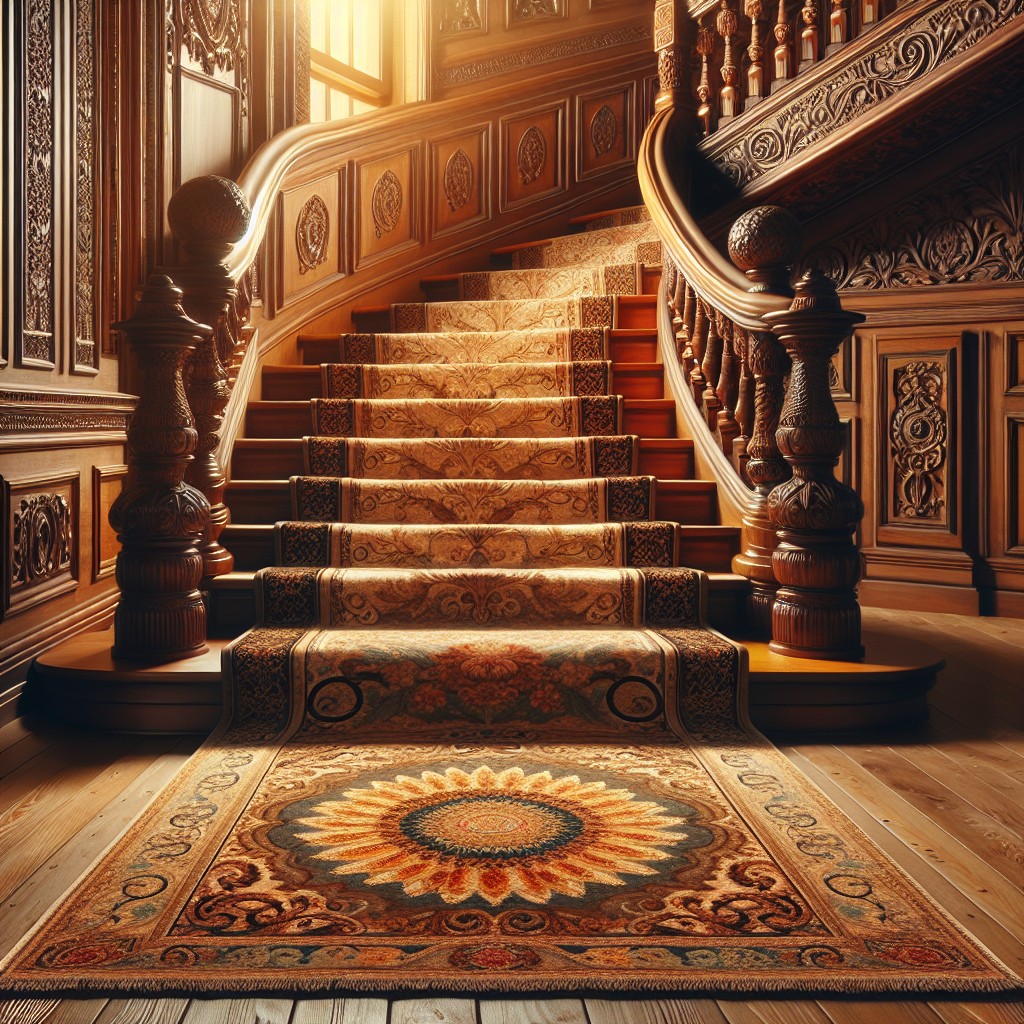
Runner carpets serve multiple purposes – they provide traction, sound absorption, and, of course, add a defining style to your staircase. Here’s how you can use them to enhance the beauty of your antique staircase:
1. Pattern Choice: Opt for patterns that complement the period and style of your staircase. Traditional motifs can underscore the antique feeling, while a modern design will establish a captivating contrast.
2. Color Palette: Dark colors, jewel tones, or Persian designs encapsulate an antique, inviting atmosphere. Should your staircase already possess a commanding presence, consider lighter, solid-color runners to balance out the visuals.
3. Fitting Method: To preserve original stair details, the waterfall method is your best bet as it drapes comfortably over the edges. However, for a polished and formal look, the French cap method, wrapping the carpet snugly around each stair, works wonders.
4. Material Selection: Wool runners are durable and bring a classic vibe, while a silk provides an opulent, softer touch. Choose one that best fits the staircase’s usage and your decor theme.
Remember, a runner carpet is not just for function but also contributes significantly to the overall aesthetics. Make sure to choose the one that best complements your antique staircase and enhances its charm even further.
Incorporating Stained Glass in Staircase Design
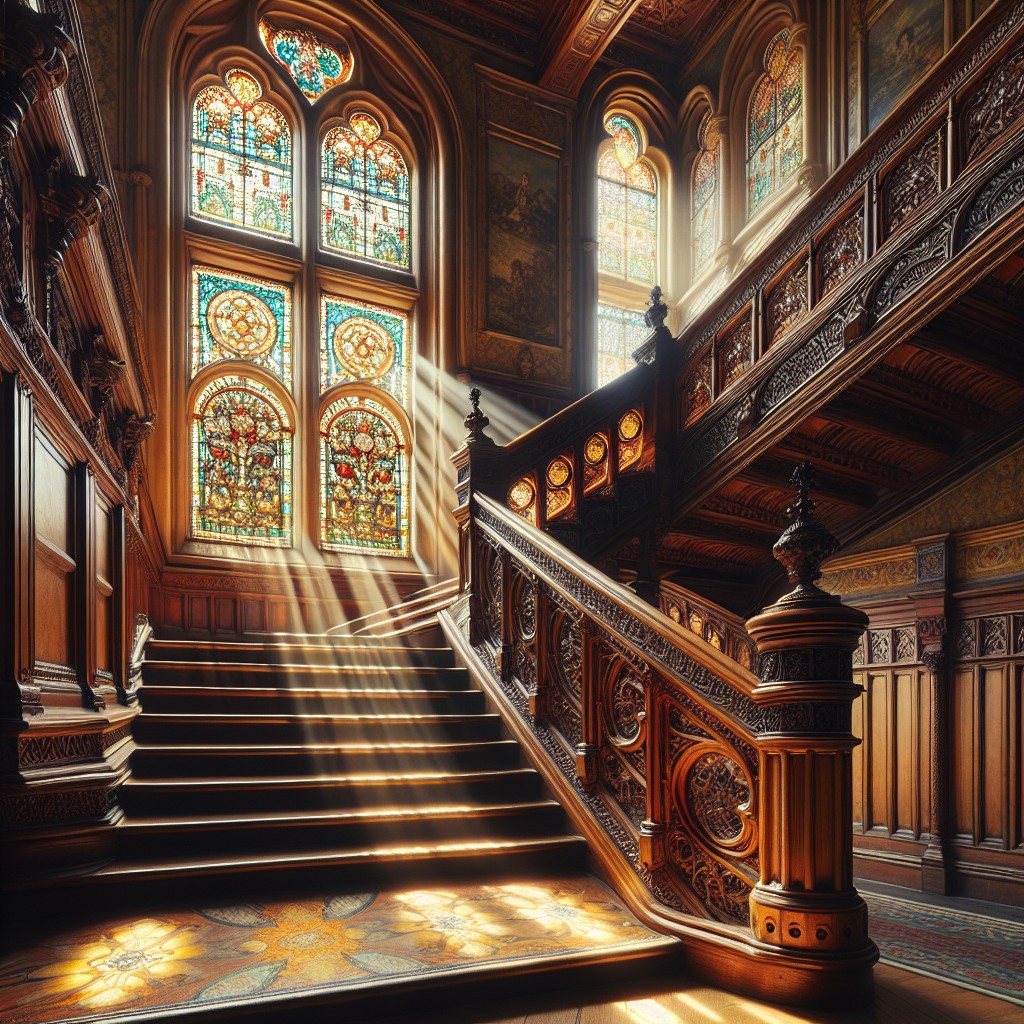
Adding an unexpected element of color and artistry, stained glass steps are a daring and unique alternative. There are a few things to keep in mind, however.
Firstly, safety is paramount. Make sure to choose durable and slip-resistant glass materials. Often, the glass is sandwiched between clear, the anti-slip safety glass for added strength.
Secondly, think about sunlight and backlighting. The glass will need some sort of light source to truly shine and show off its myriad of colors. Under-step lighting is a popular choice but consider the angle of natural light during different times of the day.
Lastly, your choice of color and pattern should ideally complement the room’s existing aesthetics. Choose a pattern that fits the home’s style—simple and abstract for a modern home, or intricate and detailed for a traditional one. Consider how the colors will play with the surroundings when illuminated.
Stained glass steps are an exciting and vibrant addition to your antique staircase, sure to make it a standout feature in your home.
Getting Creative With Tread Designs
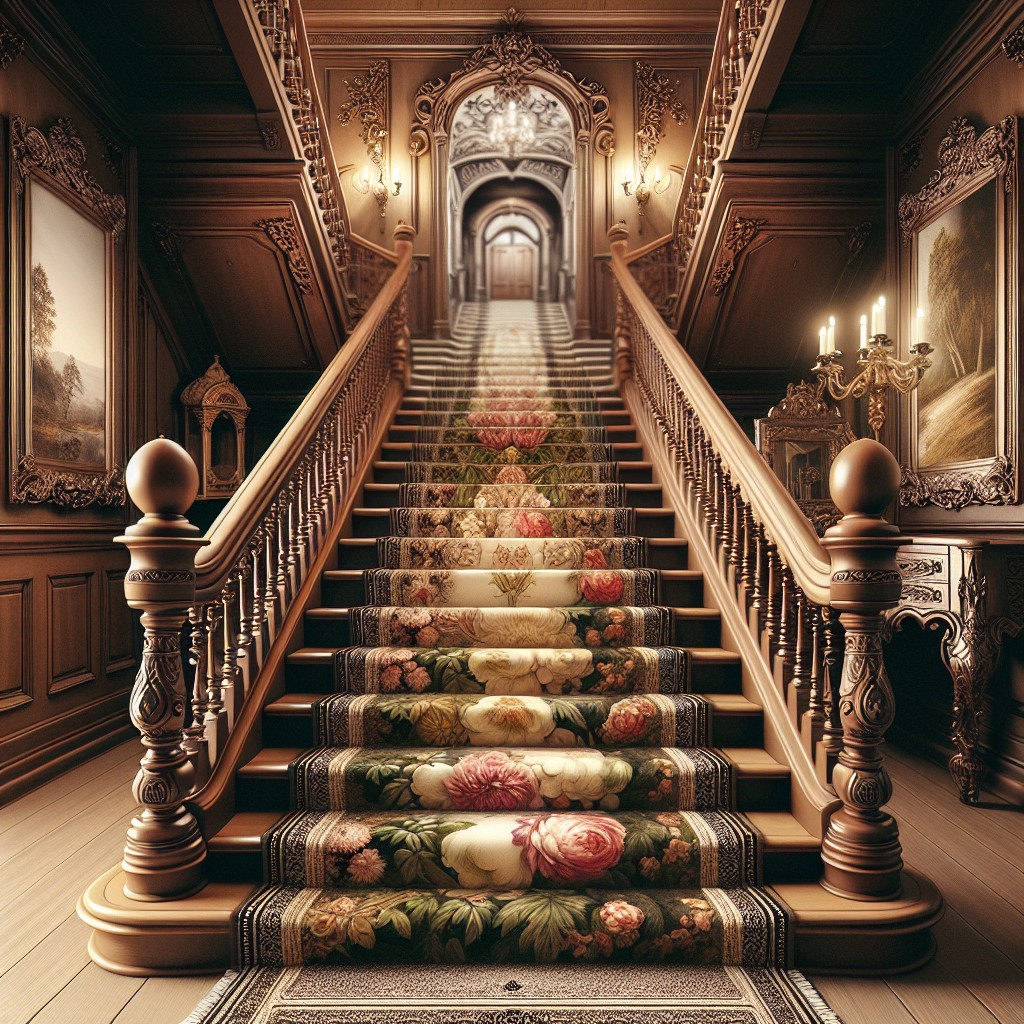
While keeping the antique essence intact, tread designs are another aspect that can add an imaginative flair to your staircase. Think about inlays with contrast colors or even patterns that accentuate the bygone charm.
1. Wood Mosaic: Classic cut wood pieces arranged in an appealing mosaic pattern can add depth to your staircase.
2. Painted Patterns: Historic homes often had painted stair treads. Emulate this style by adding patterns like stripes, numbers, or even floral designs.
3. Contrasting Wood: Blend two or more different types of wood for a striking look. This can be as simple as one type for the treads and another for risers.
4. Ceramic Tiles: Create a charming Mediterranean or eclectic style with tastefully patterned tiles.
5. Carpet Runners: They aren’t just for hallways; a patterned carpet runner can bring color and an old-school touch to wooden treads.
Remember, the goal with creative tread designs is not just beauty but also safety. Ensure the surface is non-slip and the design does not distract from safe use of the staircase.
Transforming Staircases With Chandeliers
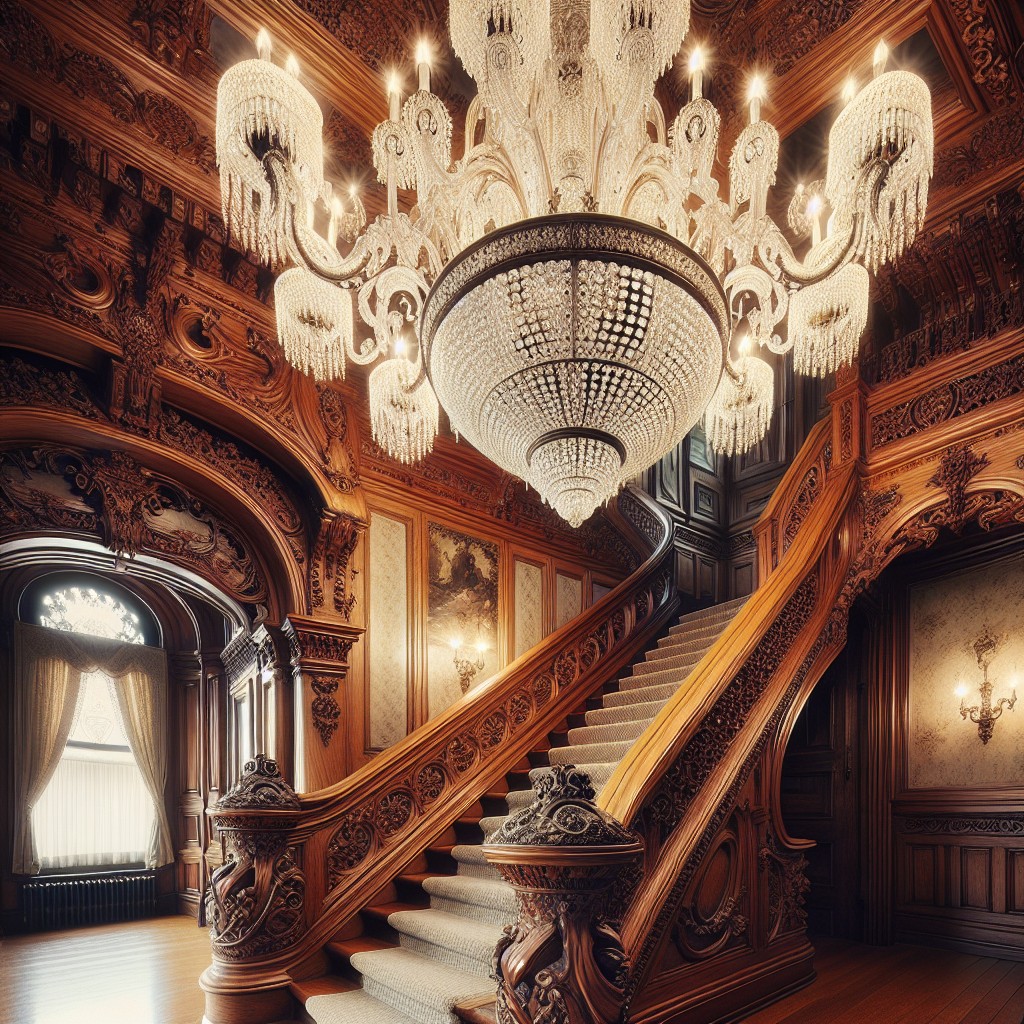
Just as essential as the structural design, is the staircase’s illumination. Chandeliers add a dash of opulence, enhancing the vintage effect. For an eye-catching result, choose a chandelier that complements your staircase’s era and style – a candelabra for Victorian homes, or perhaps an art deco piece for a 1920s setting.
An oversized chandelier creates drama, making your staircase a focal point. It’s important, however, to make sure the size and scale match the space – too big, it can overshadow; too small, it may seem inconsequential. Also consider the height – it should hang low enough to illuminate the stairs well, but not so low that it obscures the staircase view or becomes an obstacle.
To further tie the look together, use the same finish on the chandelier, the hand railing and other hardware elements. For example, if your staircase has a brass balustrade, opt for a chandelier with a brass finish.
Don’t fear asymmetry! Positioning the chandelier off-center can add an eclectic charm, making your antique staircase unique. Lastly, install a dimmer switch – this allows you to adjust the light level, setting the right mood for any occasion.
Embracing the Vintage Appeal of Wrought-iron Railings

Wrought-iron railings are more than just a barrier on your staircase; they can add an alluring timeless quality to your décor. Naturally strong and malleable, these railings are often seen with intricate designs that invoke the charm of yesteryears.
When choosing a design for a vintage look, opt for spiral, floral, or intricate geometric patterns. Black is the most classic color choice, but for a twist, consider silver, gold, or even a distressed finish.
If your wrought-iron railing is old and worn out, don’t be too quick to discard it. Restoration can bring back its former glory while preserving its authentic vintage appeal. A repainted and polished railing can be the centerpiece of your antique staircase, combining functionality with aesthetic appeal in a traditional setting.
While installing wrought-iron railings might be costlier than other options, durability and a timeless aesthetic make it a worthwhile investment. With careful selection and proper care, this feature can be an appealing focal point in your home, fondly echoing the past.
Antique Vs. Distressed: What’s the Difference?
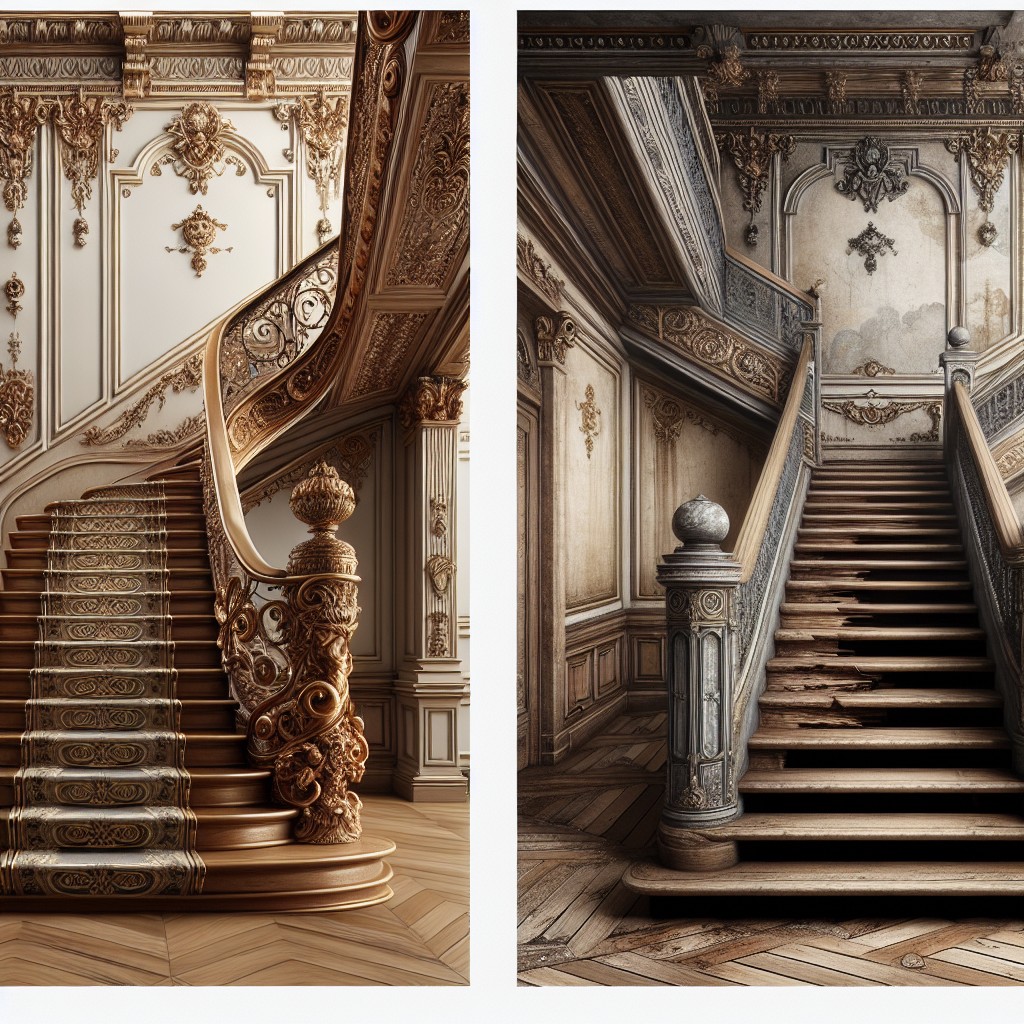
While both antique and distressed furniture have a timeless appeal, they’re distinctly unique. Antiques are pieces typically over 100 years old, showcasing craftsmanship and materials that reflect their period. They’re known for their high-quality workmanship and rarity, offering genuine historic charm.
On the other hand, distressed staircases are typically newer creations that have been intentionally weathered or aged to appear old. This is achieved through processes such as sanding, bleaching, or denting.
Making the right choice comes down to your preference between owning a piece of history or embracing the aged aesthetic with modern durability. You might also consider factors like budget and maintenance requirements. Distressed staircases often come at a lower price point and may be better suited to households with young children or pets. Meanwhile, antique staircases are typically more valuable and delicate, requiring a careful touch.
Aged Wood Staircases: How to Preserve Them

Preserving the integrity of your aged wood staircase means keeping its unique character intact without compromising safety. Start with examining the structural stability. Loose steps or wobbly railings might necessitate professional intervention.
Regular cleaning with a soft broom and damp cloth will help maintain its look while preventing dust accumulation. Avoid using harsh chemical cleaners or water; this can damage the wood over time. Wood-specific cleaners or mild soap will work well.
In terms of aesthetics, restoring the original patina of the wood can add to its timeless beauty. Handle any chipped or worn spots carefully to avoid stripping away the patina. Wood filler, followed by a light sanding, can address any gouges or deep scratches.
Sealing is another important facet of maintenance. A quality sealant offers protection from wear, moisture, and atmospheric changes. Opt for a sealant that can retain the natural hue of wood without imparting a yellowish tint over time.
Whether it’s the steps, landing, or railing, each part of your stairway has a story to tell. Enjoy its charm while guaranteeing its longevity with these preservation tips.
Why You Should Consider Brass Balustrades
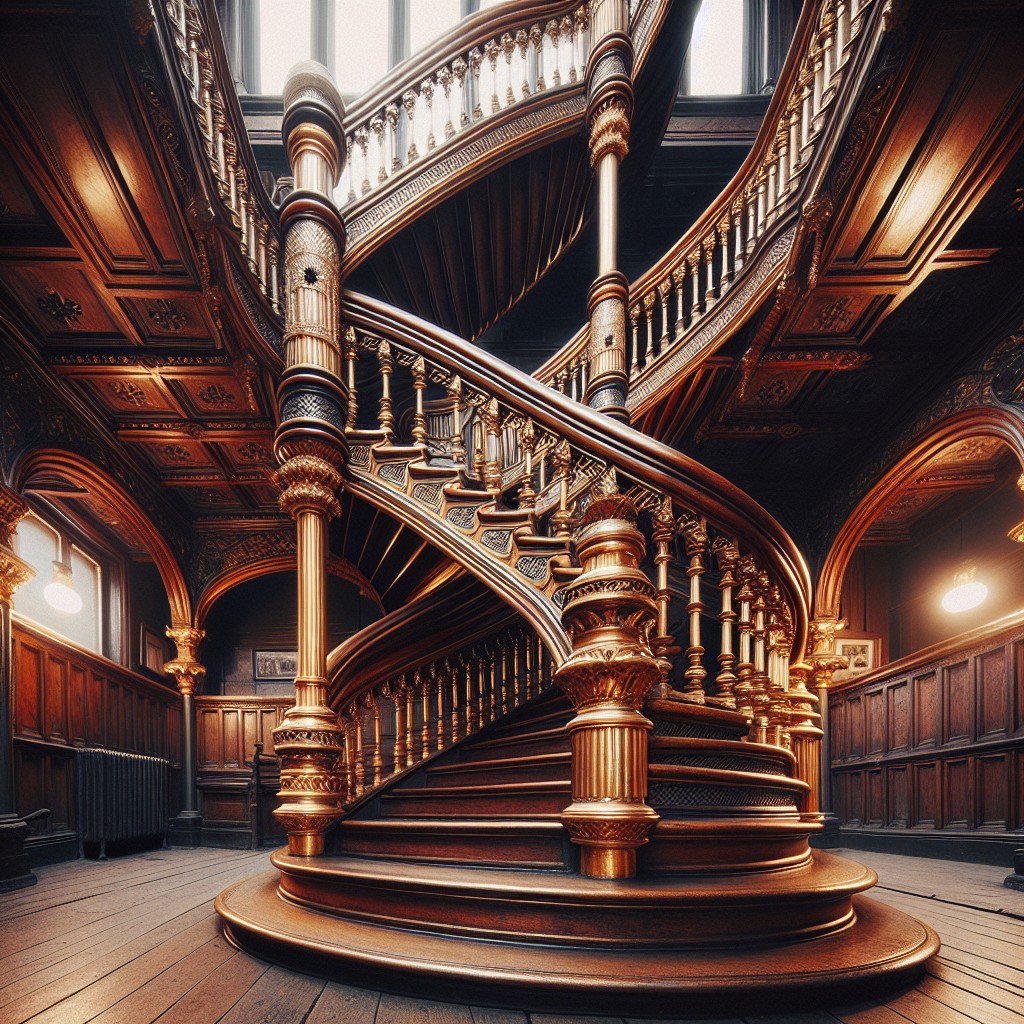
With their radiant charm and vintage appeal, brass balustrades significantly enhance the grandeur of antique staircases. This durable material withstands the test of time, maintaining its lustre and functionality for decades.
1. Classy Aesthetics: Brass instantly adds an air of sophistication and elegance to any staircase, effortlessly matching with any home décor.
2. Durability: The robust nature of brass ensures that it remains in pristine condition for long periods, withstanding daily wear.
3. Cleanliness: Brass possesses antimicrobial properties that help keep germs at bay, making it a practical and hygienic choice for balustrades.
4. Versatility: Easily adaptable to various styles, brass can be molded to create intricate designs or kept simple for a minimalistic look.
5. Possibility of Patina: For those who favor an antique look, brass patina over time adds a unique, vintage touch.
6. Easy Care: Brass requires minimal maintenance. Regular dusting with a soft cloth is sufficient to keep it gleaming.
Thus, a brass balustrade is a worthy addition to your staircase, harmoniously blending aesthetic appeal, durability, and convenience.
Antique Stairways: The Perfect Backdrop for Art Displays

Maximize your staircase’s potential by curating an art display to accentuate its antique character. Here are some tips to help you get started.
1. Balance is crucial: Create a harmonious balance between the age and style of your staircase and the artwork you display. Select pieces with complementary colors and textures for a cohesive look.
2. Vary Art Styles: Don’t limit yourself to paintings or frames only. Install intricate wall hangings, vintage signs, or even a collection of small sculptural elements to add depth and interest.
3. Use appropriate lighting: Obtain the best visual impact by illuminating your display tactfully. Consider adding pot lights, wall sconces, or even a picture light for each piece.
4. Stay Minimal: Avoid overcrowding the space. Simplicity is key in letting both your stairway and artwork shine.
5. Maintain Rhythm: Hang your artwork at eye-level or follow the incline of your stairs for a dynamic, staggered arrangement.
Treat your staircase like the masterpiece it is, allowing it to play a starring role in your home décor through a well-thought-out art display. You’ll find that it not only breathes life into the space but also pays homage to its yesteryears.
Pairing Antique Steps With Modern Walls
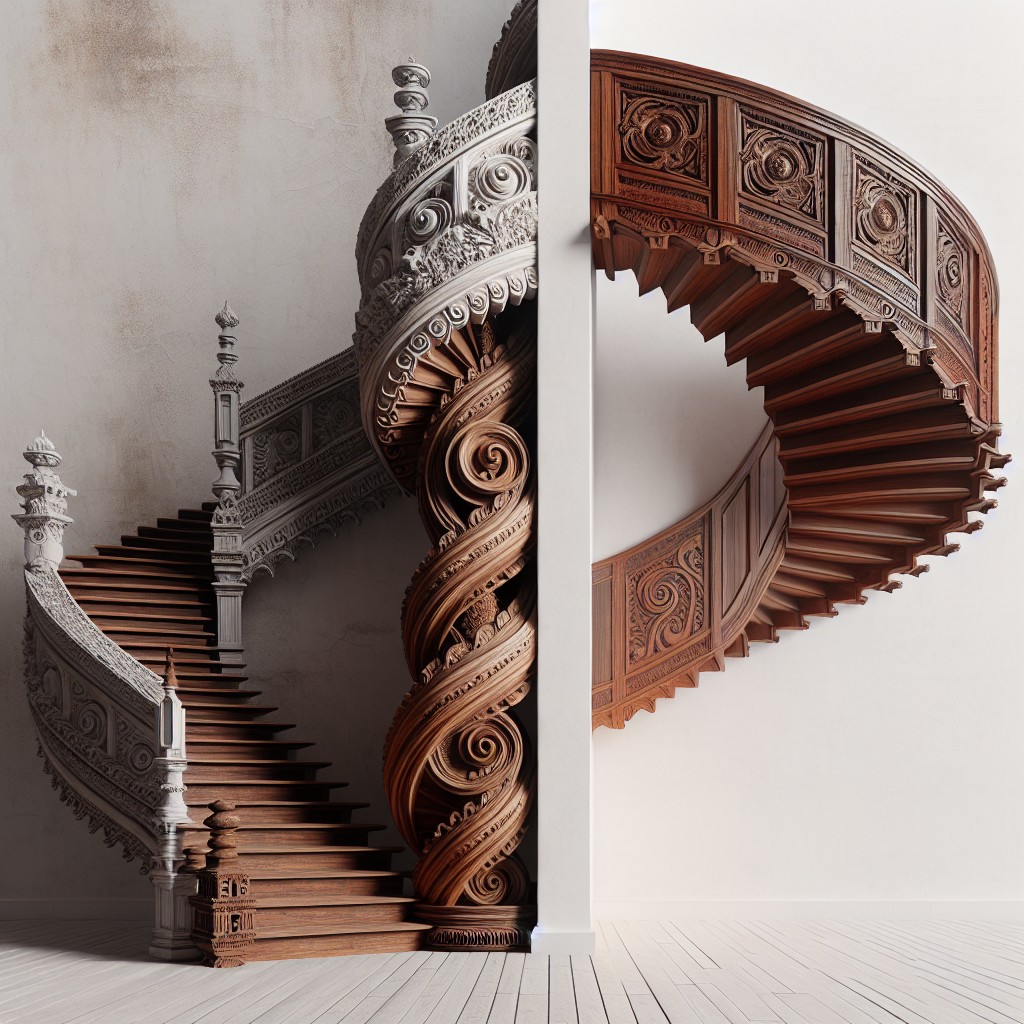
Striking a balance between old and new elements in interior design can do wonders for your home. Merging antique steps with modern walls allows a unique blend of contrasting epochs.
Here are a few points to successfully achieve this pairing:
- Color Scheme: Light, neutral colors on walls complement the rustic charm of antique wooden steps, enhancing their classic beauty.
- Wall Textures: Smooth, glossy wall finishes go well with rugged steps, offering a sensory contrast.
- Use of Wall Arts: Modern art pieces on walls can counterbalance the old-world charm of antique stairs, creating an engaging visual dialogue.
- Lighting: Modern lighting fixtures against vintage steps set up a dramatic juxtaposition, enriching the aesthetic appeal.
- Minimalism: Let the staircase shine by keeping the walls clean and simple to accentuate the focal point.
Remember, balance is the key in merging two contrasting styles, ensuring neither overshadows the other.
Winding Staircases: A Nod to Medieval Charm
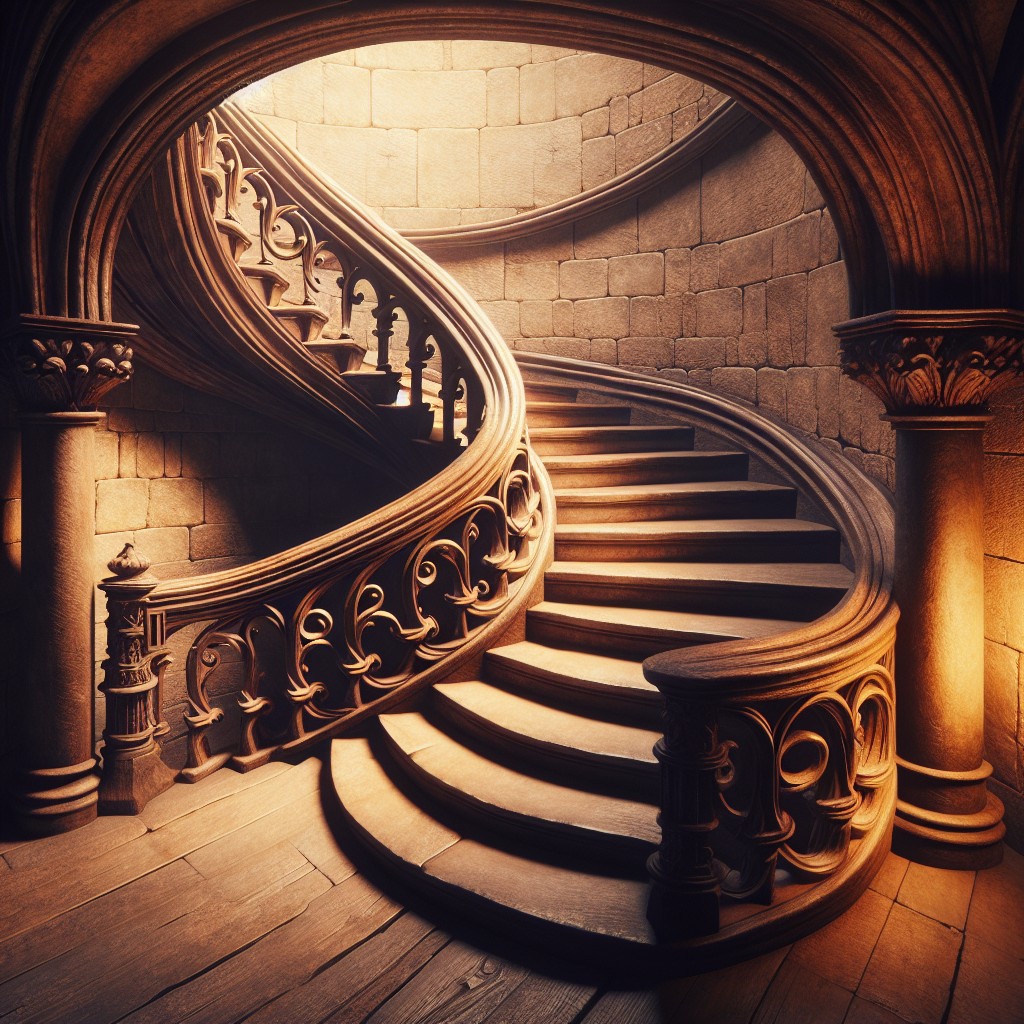
Winding staircases, particularly constructed from stone or aged wood, create an immediate sense of historical elegance. They are quite common in medieval architecture and serve as an impressive feature in a home.
To evoke that medieval charm:
- Choose Materials Wisely: Stone and dark wood are common in medieval designs.
- Add a Gothic Touch: Gothic pointed arches along the staircase can enhance the medieval theme.
- Decorate with Primary Colors: Use red, blue, or gold hues reminiscent of medieval times.
- Robust Metalwork: Think ornate iron railings or sturdy iron light fixtures.
- Keep it Rustic: Embrace the weathered and worn look for an added sense of age and uniqueness.
By paying attention to these subtle details, your winding staircase can transport you to another era.
Ornamental Handrails: Adding Exquisite Detail

Ornamental handrails can serve as the crowning glory of your antique staircase. They not only ensure safety but also add an element of intricacy and elegance.
Consider carved wood for its traditional allure — intricate filigrees and patterns create a sense of grandeur and refinement.
Alternatively, wrought-iron handrails, often associated with Victorian design, can feature elaborate scrollwork. These designs are typically custom made, allowing for meaningful details to be incorporated, such as family initials.
Lastly, brass and bronze handrails with etched or patterned detailing can bring a subtle, sophisticated glow to your antique staircase.
Whichever style you choose, ornamental handrails can breathe new life into your stairway, thereby making each climb a delightful, aesthetic experience.
How to Integrate a Slide for a Playful Antique Staircase
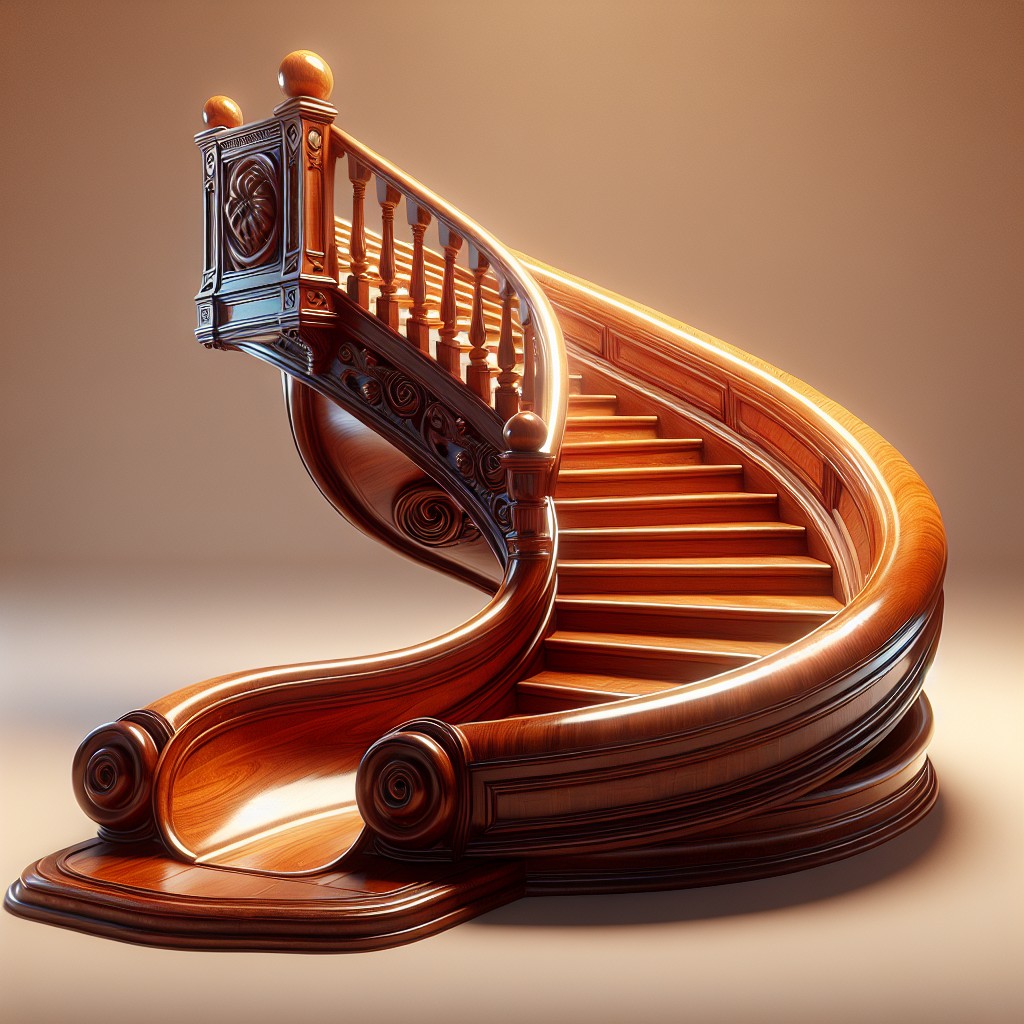
Creating a delightful blend of old world charm and contemporary fun is simpler than you might think. Slides present a unique element of surprise, and when paired with an antique staircase, you can achieve a perfect mix of nostalgia and adventure.
Here are some effective ways:
- 1. Compliment the architecture: Choose a slide design that complements the architectural style of the staircase. A spiral slide can mimic the windy effect of a spiral staircase.
- 2. Use matching materials: Material choice is critical. Consider an aged bronze or brass finish for the slide to match with your antique staircase.
- 3. Keep safety paramount: Install safety rails or a small barrier at the slide entrance. This not only safeguards against accidents but also gives an added aesthetics fitting the antique theme.
- 4. Utilize space intelligently: Space underneath the staircase can be an ideal spot to integrate the slide’s starting point. It keeps the structure cohesive and less intrusive.
- 5. Balance aesthetics: Ensure the slide does not overshadow your antique staircase. It should be an enhancement, not a distraction.
Following these tips can add a touch of whimsy without compromising on the authentic aesthetic charm of your antique staircase.
